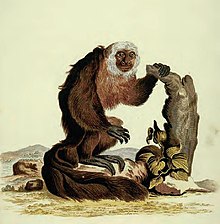Equatorial saki Description Ecology References Navigation menu"Order Primates"Mammal Species of the World: A Taxonomic and Geographic Reference62265494"Pithecia aequatorialis"10.2305/IUCN.UK.2008.RLTS.T17402A7013094.en10.1896/044.021.0101"Equatorial Saki - Pithecia aequatorialis - Overview - Encyclopedia of Life""Saki Ecuatorial (In Spanish)""Equatorial Saki Monkey""Red-bearded Saki (Pithecia aequatorialis)"e3265652436371436461085795957298717402121003633139expanding ite
IUCN Red List least concern speciesSakis and uakarisPrimates of South AmericaMammals of EcuadorMammals of PeruMammals described in 1987Taxa named by Philip HershkovitzNew World monkey stubs
saki monkeyNew World monkeyPeruEcuador![]() Pithecia aequatorialis (Equatorial Saki)
Pithecia aequatorialis (Equatorial Saki)
Equatorial saki
Jump to navigation
Jump to search
| Equatorial saki[1] | |
|---|---|
 | |
Conservation status | |
 Least Concern (IUCN 3.1)[2] | |
Scientific classification | |
| Kingdom: | Animalia |
| Phylum: | Chordata |
| Class: | Mammalia |
| Order: | Primates |
| Suborder: | Haplorhini |
| Infraorder: | Simiiformes |
| Family: | Pitheciidae |
| Genus: | Pithecia |
| Species: | P. aequatorialis |
Binomial name | |
Pithecia aequatorialis Hershkovitz, 1987 | |
The equatorial saki (Pithecia aequatorialis), also called the red-bearded saki, is a species of saki monkey, a type of New World monkey. It is found in northeastern Peru and Ecuador.[3]
Not much is known about the equatorial saki, its range being specifically unknown.[4]
Description
The equatorial saki weighs between 2 - 2.5 kg, has a head-body length of 39 – 44 cm, and a tail length of 45 – 47 cm. The species' tail in not prehensile, relying on its arm and leg strength to carry itself from branch to branch.[5] The equatorial saki is also sexually dimorphic. It is often confused for the monk saki, but the reddish throat and chest of the equatorial saki set it apart.[6]
Ecology
The equatorial saki is diurnal. The species is frugivorous, but seeds and nuts constitute a large part of diet. This species also consumes leaves and insects, especially ants. The fruits that this species consumes have hard pericarps.[7] Most of its time is spent foraging in the middle to upper levels of the rainforest canopy.[6]
They seem to be found most commonly in riverside, seasonally flooded and swamp forests, but have been seen in terra firme forests as well.[6]
The red-bearded saki moves through the forest both quadrupedally and by leaping. When the red-bearded saki takes off from a tree branch, most likely it does this from a vertical clinging position.[7]
The equatorial saki lives in small groups of two to four that come together to form larger congregations. Groups of red-bearded sakis are described as closed social units. Males groom their young.[7]
References
![]() Data related to Pithecia aequatorialis (Equatorial Saki) at Wikispecies
Data related to Pithecia aequatorialis (Equatorial Saki) at Wikispecies
^ Groves, C. P. (2005). "Order Primates". In Wilson, D. E.; Reeder, D. M. Mammal Species of the World: A Taxonomic and Geographic Reference (3rd ed.). Johns Hopkins University Press. p. 147. ISBN 978-0-8018-8221-0. OCLC 62265494..mw-parser-output cite.citationfont-style:inherit.mw-parser-output .citation qquotes:"""""""'""'".mw-parser-output .citation .cs1-lock-free abackground:url("//upload.wikimedia.org/wikipedia/commons/thumb/6/65/Lock-green.svg/9px-Lock-green.svg.png")no-repeat;background-position:right .1em center.mw-parser-output .citation .cs1-lock-limited a,.mw-parser-output .citation .cs1-lock-registration abackground:url("//upload.wikimedia.org/wikipedia/commons/thumb/d/d6/Lock-gray-alt-2.svg/9px-Lock-gray-alt-2.svg.png")no-repeat;background-position:right .1em center.mw-parser-output .citation .cs1-lock-subscription abackground:url("//upload.wikimedia.org/wikipedia/commons/thumb/a/aa/Lock-red-alt-2.svg/9px-Lock-red-alt-2.svg.png")no-repeat;background-position:right .1em center.mw-parser-output .cs1-subscription,.mw-parser-output .cs1-registrationcolor:#555.mw-parser-output .cs1-subscription span,.mw-parser-output .cs1-registration spanborder-bottom:1px dotted;cursor:help.mw-parser-output .cs1-ws-icon abackground:url("//upload.wikimedia.org/wikipedia/commons/thumb/4/4c/Wikisource-logo.svg/12px-Wikisource-logo.svg.png")no-repeat;background-position:right .1em center.mw-parser-output code.cs1-codecolor:inherit;background:inherit;border:inherit;padding:inherit.mw-parser-output .cs1-hidden-errordisplay:none;font-size:100%.mw-parser-output .cs1-visible-errorfont-size:100%.mw-parser-output .cs1-maintdisplay:none;color:#33aa33;margin-left:0.3em.mw-parser-output .cs1-subscription,.mw-parser-output .cs1-registration,.mw-parser-output .cs1-formatfont-size:95%.mw-parser-output .cs1-kern-left,.mw-parser-output .cs1-kern-wl-leftpadding-left:0.2em.mw-parser-output .cs1-kern-right,.mw-parser-output .cs1-kern-wl-rightpadding-right:0.2em
^ Marsh, L.K. & Veiga, L.M. (2008). "Pithecia aequatorialis". The IUCN Red List of Threatened Species. IUCN. 2008: e.T17402A7013094. doi:10.2305/IUCN.UK.2008.RLTS.T17402A7013094.en. Retrieved 23 December 2017.
^ Marsh, L. K. (July 2014). "A Taxonomic Revision of the Saki Monkeys, Pithecia Desmarest, 1804". Neotropical Primates. 21 (1): 1–165. doi:10.1896/044.021.0101.
^ "Equatorial Saki - Pithecia aequatorialis - Overview - Encyclopedia of Life". Encyclopedia of Life. Retrieved 2017-03-15.
^ "Saki Ecuatorial (In Spanish)". Damsiela.com.
^ abc "Equatorial Saki Monkey". Project Noah. Retrieved 2017-03-15.
^ abc Flannery, Sean. "Red-bearded Saki (Pithecia aequatorialis)". www.theprimata.com. Retrieved 2017-03-15.
This New World monkey-related article is a stub. You can help Wikipedia by expanding it. |
Categories:
- IUCN Red List least concern species
- Sakis and uakaris
- Primates of South America
- Mammals of Ecuador
- Mammals of Peru
- Mammals described in 1987
- Taxa named by Philip Hershkovitz
- New World monkey stubs
(window.RLQ=window.RLQ||[]).push(function()mw.config.set("wgPageParseReport":"limitreport":"cputime":"0.800","walltime":"1.039","ppvisitednodes":"value":9082,"limit":1000000,"ppgeneratednodes":"value":0,"limit":1500000,"postexpandincludesize":"value":72528,"limit":2097152,"templateargumentsize":"value":6480,"limit":2097152,"expansiondepth":"value":16,"limit":40,"expensivefunctioncount":"value":10,"limit":500,"unstrip-depth":"value":1,"limit":20,"unstrip-size":"value":22527,"limit":5000000,"entityaccesscount":"value":11,"limit":400,"timingprofile":["100.00% 970.769 1 -total"," 60.69% 589.124 1 Template:Speciesbox"," 59.53% 577.863 1 Template:Taxobox/core"," 22.77% 221.005 1 Template:Reflist"," 15.23% 147.825 1 Template:MSW3_Primates"," 14.95% 145.178 1 Template:Cite_book"," 12.24% 118.831 46 Template:Delink"," 9.34% 90.676 1 Template:Taxonbar"," 3.90% 37.852 3 Template:Navbox"," 3.18% 30.919 1 Template:Pitheciidae_nav"],"scribunto":"limitreport-timeusage":"value":"0.601","limit":"10.000","limitreport-memusage":"value":5202304,"limit":52428800,"cachereport":"origin":"mw1261","timestamp":"20190403132731","ttl":2592000,"transientcontent":false);mw.config.set("wgBackendResponseTime":114,"wgHostname":"mw1272"););